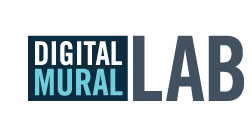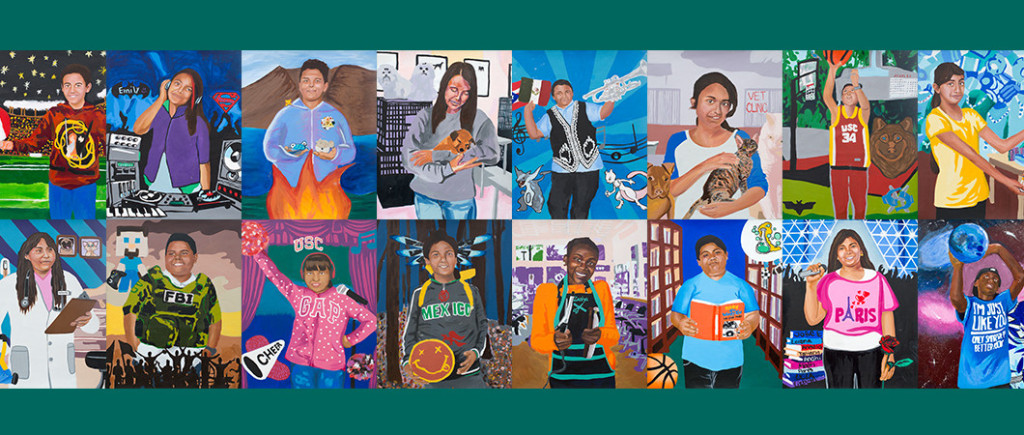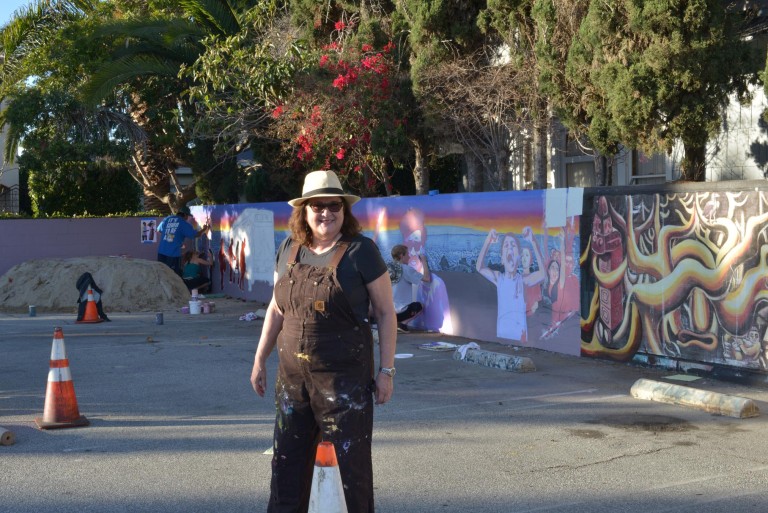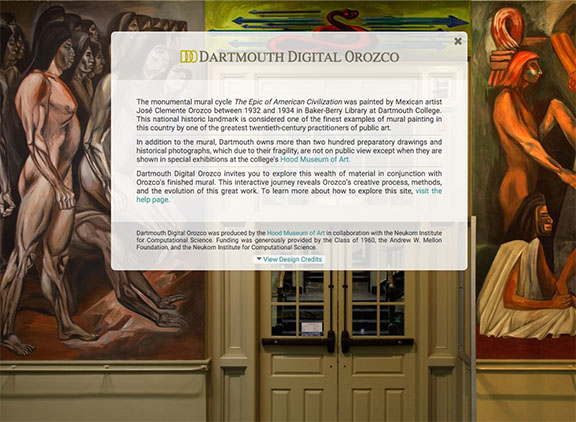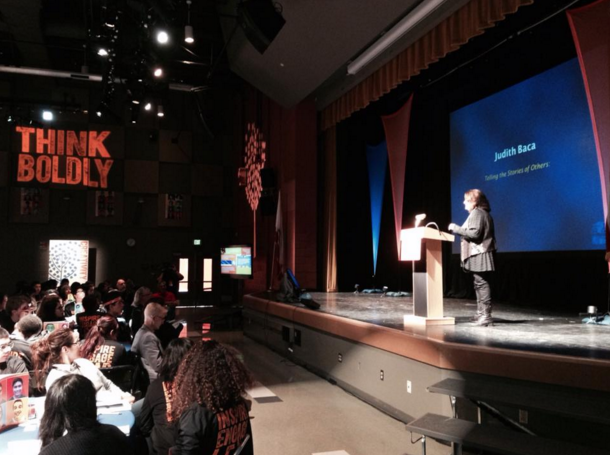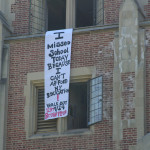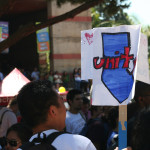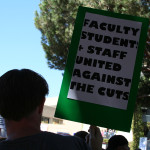The Judy Baca Arts Academy represents the tremendous potential for creative learning endeavors within the Los Angeles Unified School District (LAUSD). We believe that academic pre- paredness means placing art, creativity and self-exploration at the center of the scholastic journey. The Emancipation Project, a collaboration between University of California Los Angeles (UCLA) and the Judy Baca Arts Academy (JBAA), reflects this ideology. The four-week workshop pairs members of a 6th grade class with university students enrolled in the Beyond the Mexican Mural studio course through the UCLA@SPARC Digital Mural Lab.
Under the direction of Professor Judy Baca, undergraduates assist and mentor JBAA stu- dents as they create life-sized self-portraits. Beginning as photographs, these images transform into hand painted portraits reflecting memory, identity and aspirations. The individual portraits will be installed together in the school’s outdoor eating-area as a unified image of “emancipation,” commemorating the students’ graduation from elementary school, while celebrating their future achievements within academia and beyond.
UCLA@SPARC: today, students in Professor Judy Baca’s Chicana/o Studies course, Beyond the Mexican Mural, are engaging in a mural production at SPARC… entitled, “LA Tropical”, the production offers students insight on how to facilitate collaborative community projects. Based on student research, the mural reflects the lives of ordinary Angelinos in a meaningful visual narrative. Stay tuned for the final product next week!
[easymedia-gallery med=”4418″]




For more information, videos of the challenges, and the proposals led by LAUSD students, visit:
Sparcinla.org
Digitalmurallab.com
Judybaca.com
www.aspeninstitute.org
Maybe you mean: 'home-agency' or 'home-business' or 'home-creative3' or 'home-minimalist' or 'home-shop' or 'home-solution'
Maryland Institute College of Art (MICA) is an art and design college in Baltimore, Maryland, USA. It was founded in 1826 as the Maryland Institute for the Promotion of the Mechanic Arts, making it one of the first and oldest art colleges in the United States. In 2008, MICA was tied for #4 in the nation among fine arts master programs by US News and World Report, and its Graphic Design Master of Fine Arts program tied for #6 among graduate schools for Graphic Design. MICA is also a member of the Association of Independent Colleges of Art and Design (AICAD), a consortium of thirty-six leading art schools in the United States, as well as the National Association of Schools of Art and Design (NASAD).
Judy Baca speaks about art and public space in Los Angeles at the Hammer Museum.
Public art has long been a site for negotiating community and contesting urban territories. Using the mural as a jumping off point, panelists will engage in a discussion about public art, community identity, art and activism, and new models for socially-engaged art practice. The panel includes artist Edgar Arceneaux, founder and director of Watts House Project; Judy Baca, artist and founder of SPARC (Social and Public Art Resource Center): interdisciplinary artist Sandra de la Loza, founder of Arts and Action; and Christine Y. Kim, associate curator at the Los Angeles County Museum of Art (LACMA) and co-founder of the public art organization Los Angeles Nomadic Division (LAND). Moderated by Chon Noriega, director of the UCLA Chicano Studies Center, this program is one of the events commemorating the 40th Anniversary of the UCLA Chicano Studies Research Center and other ethnic studies center at UCLA.
We are a city of nations: a myriad of peoples from all over the world joined by a sprawling network of freeways and shared geography.
Los Angeles 2010 brings even more diversity and global economic struggles combined now with local downturns that doubly affect Angelinos. Our schools face challenges to educate diverse children in a nearly bankrupt state, as those under 18 have become the largest segment of our population.
The arts play a critical role in the up lifting of the human spirit and the expression of our deepest shared values as people. They can bridge difference between people,
articulate a vision of hope and change for a community. They can, through creative collaborative processes, teach us how to live and work together in the most productive ways.
In this next year, we at the Social and Public Art Resource center will bring together another group of youth to work on the restoration of my ½ mile long mural on the history of California Mural called the Great Wall of Los Angeles Mural which focuses on the contributions made by immigrants and populations of color in the Los Angeles area. This work now 33 years old in some areas will be completely restored and a new interpretive Green Bridge built over the site which will serve as viewing station with interpretive panels. Our plans to extend the mural will empower another generation of youth to continue beyond my lifetime to interpret our evolving history.
In addition in 2010, we will create two interactive Digital Murals: Tiny Ripples of Hope and Seeing Through Others Eyes and install them in the new Robert F. Kennedy K-12 Learning Center on the site of the historic Ambassador Hotel. This work will through new touch screen technology and geo-mapping offer the images of the mural to allow students to delve into the representations in the mural of the issues defined by Robert F. Kennedy as the most salient issues of the 1960’s and also of our time:
-War, Healthcare, Poverty, Intolerance, Environment and Education
The UCLA/SPARC Cesar Chavez Digital Mural Lab and LAUSD RFK Learning Center will collaborate to produce a multi-layered interface program, which will enable students to interact with the library murals through touch screen technology to explore the mural’s content and accompanying curriculum. The students will expand through real life application the social justice curriculum by social action in their communities that is recorded and shared. The interactive curriculum based program will use the digital murals as a launching pad to link to bibliographies, articles, images, and recorded interviews collected and geo-tagged during the artist’s research period and the student’s own exploration in their own diverse neighborhoods creating a virtual map of issues in the City of Los Angeles.
The main demands of the UC strike are the following:
1. We demand that the Regents vote no on the proposed fee increases.
2. We demand that the UC stop cuts and layoffs, and end its aggressive union-busting tactics.
3. We demand transparency of the UC budget, including complete figures on how much of the additional revenue from fees will be diverted for construction and used as bond collateral.
4. We demand that the Regents expand enrollment of underrepresented groups and ensure equal access to education for all by maintaining all educational institutions as sanctuary spaces for undocumented students and workers and by providing adequate financial aid for undocumented and underrepresented students.
5. We demand an explanation for the failure of the UC leadership to make an effective case for public higher education. As both students and taxpayers, we demand leaders who can make that case, and an administration whose transparency can once again inspire the confidence of the state and its citizens.
The art department of GCSU invited Judy Baca to hold a day-long workshop for Advanced Painting Students on March 5, 2009 to learn the techniques, practice and theory that she has cultivated over her 30+ years as an artist and teaches her UCLA class, Beyond the Mexican Mural. Though it would be impossible for a one-day workshop to cover as much material as a full ten- to twenty-week course, Baca’s workshops are in depth and rigorous. In only 5 hours, she was able to turn twenty individual art students into one mural team moving from “Affinity Groups” to sketches to full composition and finally blue-line on the wall. Their professors will see them through paint application.


1. Judy Baca introduces herself and her mural process which follows the theory of Paolo Freire in which content is derived from the overlapping stories of participants.

2. Students are given ten index cards each. They are asked to write on each card a life-defining epiphany and what they learned from the experience, then place the cards on the wall.

3. Students organize cards based on subject matter and create categories (i.e. substance abuse, advice from elders, love, communication, creativity.)

4. Once all the cards are categorized, students are instructed to stand in front of the category with which they most identify, creating “Affinity Groups.”

5. Affinity Groups break off the conceptualize their subjects. Each group will have 2-4 students who will begin by discussing the topic. Often times, each member will produce their own individual sketch but each group will ultimately complete one collaborative drawing.

6. As groups complete their drawings, Judy begins to determine composition and assigns each group to a portion of the gridded wall.

7. Students transfer their drawings onto the wall with charcoal following both their grids and the musical ratio of space division that Judy determines using the Punto system of David A. Siqueiros

8. Once charcoal drawings are complete, outlines are painted on with diluted aquamarine paint.
To complete a mural from start to finish requires a minimum of a two- to three-day workshop. In only one 5-hour day, Judy was able to orchestrate the conceptualization and drawing of a mural that will be colorized by the painting students over the rest of their semester with instruction from Professor Valerie Aranda (far right).
Stay tuned for updates as the students finish their work in Georgia . . .

Students of the GCSU Mural Workshop (at the end of a very long and productive day with Judy Baca). March 5, 2009.
Progress is made: The students continue to lay in blue-line for outlines and underpainting (images sent in by GCSU professors).




Students paint over the blue-line with acrylic paint
